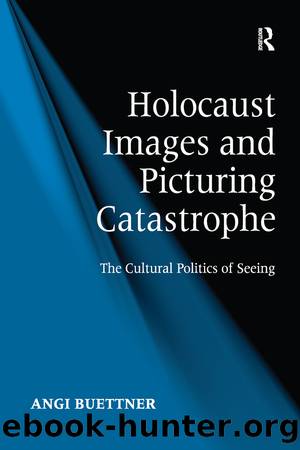Holocaust Images and Picturing Catastrophe by Angi Buettner

Author:Angi Buettner [Buettner, Angi]
Language: eng
Format: epub
ISBN: 9781138268302
Barnesnoble:
Publisher: Taylor & Francis
Published: 2016-11-17T00:00:00+00:00
Nachtwey does not explicitly refer to the Holocaust as an influential factor influencing his work. Nonetheless, a look at his oeuvre reveals how strongly he draws on Holocaust imagery to construct âour visual historyâ and âcollective memoryâ. The quote also echoes Holocaust rhetoric. It ends on a variation of the âNever Againâ slogan: the events he photographs, so Nachtwey, are not to be âforgottenâ and not to be ârepeatedâ. And being a witness is one of the key tropes of Holocaust discourse. Jeffrey Shandler (1999) has described how central the trope of witnessing has become with the film footage documenting the Allied liberation of Nazi concentration camps. Viewing liberation footage was established as an act of witnessing the conditions of recently liberated camps, and as a morally transformative experience (Shandler 1999: 5â8). Nachtwey also uses these two tropes as the motto of both his web and Facebook page: âI have been a witness, and these pictures are my testimony. The events I have recorded should not be forgotten and must not be repeatedâ (jamesnachtwey.com). Strong examples of Nachtweyâs use of the Holocaust frame are two of his famous photos that work with the trope of suffering and starving figures.
One is titled âAfghanistan, 1996â. It is a silver gelatin photograph showing a figure wrapped up in a burka on hands and knees, crouched between grave stones.7 The other one is from Sudan in 1993, captioned âA starving man moved towards an emergency feeding compound (Nachtwey 1999: 176â177, available also on Time.com, âInferno: Photo Essay by James Nachtweyâ, 2000). It also is a blackand-white photograph, and shows a naked, starving man crawling on hand and knees on the dirt ground. Both photographs are strongly reminiscent of Holocaust images depicting the suffering in ghettoes that have become widely used. The two Nachtwey photographs have exactly the same composition as an iconic photo from the Warsaw ghetto. It is titled âThe last journey: death and burial in the Warsaw ghettoâ, and reproduced in a pictorial history of the Holocaust published by Yad Vashem (Yitzhak 1990: 160). It shows a man, clad in a black coat, starving, and crawling on hand and knees.
Many of Nachtweyâs photos from the war and conflict zones of the world, more generally draw on the iconic and compositional strength of the distorted, two-dimensional figures in Holocaust sculptures, either as individual bodies or groups, such as Françoise Salmonâs bronze sculpture The Unknown Prisoner, in Neuengamme (Figure 5.1).
The stick-like bodies from Holocaust vintage photographic images are among the most dominant tropes of Holocaust imagery. Images of the piles and mass of corpses and the rendering of the pile of bodies (by bulldozers, for example) soon began to run parallel with depictions of the one skeletal body. In the many images of stick-like bodies, the victims are refined for purposes of representation. The ultimate refinement of this aesthetic possibility can be seen in many Holocaust memorial sculptures, sculptures that often form solidified bodies and similarly refine and emphasise the body, but also often barely are three-dimensional sculptures.
Download
This site does not store any files on its server. We only index and link to content provided by other sites. Please contact the content providers to delete copyright contents if any and email us, we'll remove relevant links or contents immediately.
Technical Art History by Jehane Ragai(443)
Art, Science, and the Natural World in the Ancient Mediterranean, 300 BC to AD 100 by JOSHUA J. THOMAS(399)
Graphic Culture by Lerner Jillian;(391)
The Slavic Myths by Noah Charney(360)
Pollak's Arm by Hans von Trotha(331)
Simply Artificial Intelligence by Dorling Kindersley(330)
Treasuring the Gaze by Hanneke Grootenboer(330)
Sketchbook Confidential: Secrets from the private sketches of over 40 master artists by Editors of North Light Books(326)
The Art of Portrait Drawing by Cuong i(324)
Drawing for the Soul by Zoë Ingram(318)
Drawing Landscapes by Barrington Barber(312)
The Art of Painting Sea Life in Watercolor by Maury Aaseng Hailey E. Herrera Louise De Masi and Ronald Pratt(301)
Mountain Manâs Field Guide to Grammar by Gary Spina(299)
Portrait of a Woman by Bridget Quinn(288)
A text-book of the history of painting by Van Dyke John Charles 1856-1932(280)
Anatomy for the Artist by Jennifer Crouch(279)
Preparing Dinosaurs by Wylie Caitlin Donahue;(274)
Botanical Illustration by Valerie Price(271)
Egyptian art by Jean Capart(266)
